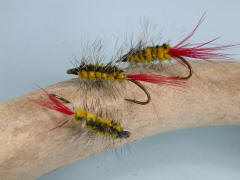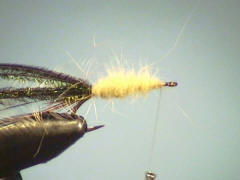|
Flies for All Fish
Joe Cornwall has been fly fishing and tying flies and jigs for well over
30 years. He authored the award-winning book Fly fishing Warm Water
Rivers which can be found at www.flyfishohio.com.
Joe is a member of the Outdoor Writers of America and the Outdoor Writers
of Ohio. He won the 2004 and 2005 OWO award for Best Outdoor
Magazine Column for his work in Country Anglin’ Outdoor Guide.
A smallmouth bass fanatic at heart, Joe is happy to fish for anything
with fins. In this monthly column Joe will share the patterns he’s found to
work best in our local waters and for our local game fish.
|

|

Volume 7, Issue 7
July 2006
The Crackleback Wooly Worm
Fly and Text by Joe Cornwall
Photography and Video Production by Jim Stuard
Heddon lure collectors will recognize the word
"crackleback" because of its use in conjunction with the color
patterns of many of the classic Dowagiac artificials. Some fly fishers may recognize the Crackleback
as a popular dry fly pattern, attributed to Ed Story of Feathercraft fly shop
in St. Louis. I believe I first saw this name associated
with this pattern in a book by Dave Whitlock.
One thing is certain, I've had this pattern
as a regular citizen of my fly box for at least twenty-five years. As a boy growing up in Massachusetts a wooly worm in yellow or green with a
peacock herl back was de rigueur for sunfish and perch.
There are times when this fly is a magic elixir for
bluegill. From the moment the water
temperatures reach seventy-degrees until the humid days of late July this is
my most productive subsurface pattern for panfish. Through August and into early September I
have my best luck on the deep-holding gills using classic northwest-style
chironomid presentations. For the
first three months of the season this is the "go to" fly for me,
though.
I prefer a heavy wire hook over lead weighting with this
fly. This includes using
bead-heads. A slow sink rate helps
this fly work its magic. I always tie the Crackleback with an oversize
dry-fly quality hackle. The large
barbs help keep the fly weedless and the stiff nature of the hackle pushes a
good wake in the water. It's my
opinion that this combination of sonic presence and high contrast that makes
the Crackleback easier for predators to find.
For an even more effective presentation, fish this fly behind the
smallest silver Hildebrandt in-line spinner and hold on! The combination makes a great trolling pattern, too!
I
click on picture for larger view
MATERIALS
Hook –
Mustad C53S, size 6 to 12
Thread –
Black or yellow 6/0, 140 denier
Tail –
red or claret hackle fibers - also try Antron yarn
Body
– Yellow, primrose, ginger or cream
dubbing or chenille
Back –
Peacock herl, four to six depending on the size of the fly
Ribbing
– Small copper wire, for a lighter fly use black size A thread
Hackle –
dry fly quality neck or saddle, grizzly or barred ginger
 click here to download video
click here to download video
TYING STEPS
…click on picture for larger view
|
1. Mount the
hook in the vice and attach the tying thread. Wrap a smooth underbody to the point where
the tail will be tied in, then wrap back to the midpoint. Tie in the tail material and wrap back to
the bend. with
this fly I like to stagger the tie-in points to get a curved back
appearance.
|

|
|
2. Tie in a
length of small copper wire to be used as a rib.
|

|
|
3. Select a neck
or saddle hackle. Try to find a
quality hackle with barbs about 1.5 times the hook gape at the widest
point. Tie the hackle feather in by
the tip and stroke the barbs back from the hackle stem.
|

|
|
4. Tie on four to
six peacock herls, depending on the size of the fly you are tying. Tie the herls on in front of the other
materials, continuing to build a humped back underbody. Wrap back to the tail tie-in point.
|

|
|
5. Dub a thick
body. You can use carded wool, rabbit or
squirrel. Small chenille or wool
yarn works very well also. Pull over the peacock herls, but don't pull them
tight. Leave a bit of play in the
herls so they don't snap when they get wet.
|

|
|
6. Palmer the
hackle forward in six or seven wraps. Some tiers prefer to make the wraps
denser at the head/thorax of the fly rather than making them equally
spaced. Experiment and see what works for you!
hackle.
|

|
|
7. Counter-wrap
the copper wire to re-enforce the peacock and hackle quills. Break off the copper wire after tying it
down at the head to get a good, smooth finish.
|

|
|
8. Wrap a thread
head, whip finish and cement. The
Crackleback is ready to fish!
|

|
Till next time, tight lines and gentle breezes…
|
